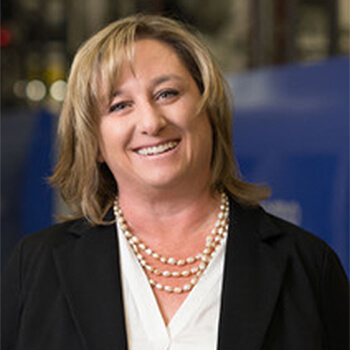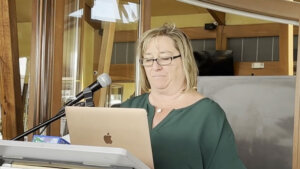
TYPE OF STROKE: HEMORRHAGIC
 Hello and thank you for being here. I am Tammy Barras. I am a mother, a wife, a daughter, a sister, and I am president of a plastic injection molding company, just under two years ago, in October 2023. I became something I had never imagined: a Stroke Survivor. It was just a regular Friday. I went to work, come home, and had dinner with my husband. I had a mild cold, I went to bed and woke up about an hour later, coughing, which caused a severe headache so horrible that when I tried to lie back down, I was unable to do so. At that point, my husband and I decided to call 911. I had no stroke symptoms when we first made the call, but by the time the ambulance arrived, and I was on the gurney in the back of the rig. The left side of my face had begun to droop, and my speech had become slurred. They rushed me to Kaiser Cottle, during which I heard the paramedic say “she is stroking out in on me, she’s stroking out on me.” That’s pretty much the last thing I remember for about a month. After being admitted to Kaiser Cottle, I received a CT scan and other stabilizing treatment. The next day, I was transferred to the neural ICU in Redwood City, where I stayed for just under two weeks. I had a massive hemorrhagic stroke in my right basal ganglia, which caused severe swelling. So much that it caused my brain to shift from midline to the left about a half inch. They worked hard to stabilize the swelling in my brain. Once it was determined I was stable, they transferred me to KFRC– Kaiser‘s stroke rehabilitation center. It wasn’t until I arrived at rehab that I realized I was unable to walk or use my left arm. Surprisingly, I was unaware of how disabled I was! I remained at KFRC REHAB FOR 18 days. Completing a very intensive program of daily PT, OT, and cognitive therapy. Little did I know this was just the beginning!
Hello and thank you for being here. I am Tammy Barras. I am a mother, a wife, a daughter, a sister, and I am president of a plastic injection molding company, just under two years ago, in October 2023. I became something I had never imagined: a Stroke Survivor. It was just a regular Friday. I went to work, come home, and had dinner with my husband. I had a mild cold, I went to bed and woke up about an hour later, coughing, which caused a severe headache so horrible that when I tried to lie back down, I was unable to do so. At that point, my husband and I decided to call 911. I had no stroke symptoms when we first made the call, but by the time the ambulance arrived, and I was on the gurney in the back of the rig. The left side of my face had begun to droop, and my speech had become slurred. They rushed me to Kaiser Cottle, during which I heard the paramedic say “she is stroking out in on me, she’s stroking out on me.” That’s pretty much the last thing I remember for about a month. After being admitted to Kaiser Cottle, I received a CT scan and other stabilizing treatment. The next day, I was transferred to the neural ICU in Redwood City, where I stayed for just under two weeks. I had a massive hemorrhagic stroke in my right basal ganglia, which caused severe swelling. So much that it caused my brain to shift from midline to the left about a half inch. They worked hard to stabilize the swelling in my brain. Once it was determined I was stable, they transferred me to KFRC– Kaiser‘s stroke rehabilitation center. It wasn’t until I arrived at rehab that I realized I was unable to walk or use my left arm. Surprisingly, I was unaware of how disabled I was! I remained at KFRC REHAB FOR 18 days. Completing a very intensive program of daily PT, OT, and cognitive therapy. Little did I know this was just the beginning!
Like some of you, my life changed drastically overnight!
At KFRC, we worked diligently on my therapies, teaching me to walk again, improving my cognitive abilities, and trying to wake up my left arm. At the time, I was convinced that I was going to wake up one morning and all would be well. I still didn’t truly understand the challenges ahead of me in fact, I clearly remember one of my physical therapists telling me how happy she was when one of her old patients came in to see her after three years and he was finally walking normally and able to use his arm and I thought to myself oh my gosh, three years How am I ggoing to make it to three years and yet here I am two years later still working, still struggling, still moving through this path. I was released from KFRC rehab a few days before Thanksgiving and as you can imagine, I was very grateful to be home and out of the hospital after more than a month we had a fantastic Thanksgiving day with my immediate family—my kids and their spouses and my mom and dad, but the next day I wasn’t feeling well I was having a hard time catching my breath. We ended up having to call 911 again and discovered that I had a massive blood clot in my lungs straddling my Heart. This created yet another life or death situation and required an emergency thrombectomy the day after Thanksgiving, however, this also created quite the quandary for the doctors since the typical treatment for blood clots is blood thinners, but since I had recently had that massive hemorrhagic stroke they didn’t want to start the bleeding in my brain again either so I had to spend another week in ICU as they decided how best to treat me, thankfully, they chose the right medication and I have new had no further issues.

Watch Tammy’s keynote at this year’s GOLF 4LIFE.
I can say that I have been extremely blessed throughout this entire journey to be surrounded by family and friends who have loved me, supported me, and encouraged me. For that, I am forever grateful. My husband and I had only been married for 5 years when I had my stroke, being my caretaker was certainly not in the plans!! But he stepped up and carried the load gracefully, with kindness, and with a ton of love!
There have been many lessons learned through this journey. i, I would say the most important lesson is the impact of being surrounded by the love of family, friends, and work associates, and not realizing it as deeply as I should have before my stroke. It’s so easy to take life for granted when you’re just living day-to-day, you don’t think about walking up stairs or giving somebody a hug or hanging up your shirt. You just do it. You don’t realize how much effort it truly takes. Slowing down and concentrating on things has shown me how much I have taken for granted. Today, I watch people walking past me, and I constantly think to myself, “If only they knew how lucky they are,” but that’s not their lesson. It’s mine. I have had to learn to be patient, slow down, and concentrate step-by-step. What needs to happen for me to say Stay safe.
As I mentioned earlier, I ran a plastic injection molding company before my stroke. Thankfully I had a strong team in place when I got sick. They were able to take over and run the company for me for the six weeks or so that I was out however, upon my return in early January 2024 , there was a lot of disruption and confusion because they didn’t think I was ready to come back and had enjoyed the freedom of being in charge, but I was ready to come back. My doctor encouraged me to come back in fact, the super encouraging words of my neurologist, were, ” do not sit home and be a vegetable, get out and do things”, so I pushed myself to return to work with limitations. Instead of working 50 to 60 hours a week. I now work just two days, in the office, for a total of eight hours in the office per week, and the other three days remotely from home. I limit my interaction with customers and allow my team to carry the load, so I still have energy to work on my recovery. It has all been an enormous learning process for me, and I have had to learn what my new limitations are now, because my brain is different. My thinking process is different. Previously, I could hold conversations and type fluently without any issues. Now, I am not able to do that for one typing is very challenging with one hand and two my brain cannot currently handle multiple tasks like it did in the past, so I have had to learn to manage what my current capabilities are.
I’ve also learned the importance of words and how strong they are to your brain if your brain says or thinks something your mind believes it to be true so it’s very important to stay as positive as possible and not limit yourself. You will hardly ever find me saying I can’t do something. I’ll mention that my arm isn’t working right now. I am unable at this time, I can’t do it YET, but I will. I will continue working, and I have confidence that I will continue to get better. It’ll be slower than I want, but slow progress is better than no progress. A few weeks ago, I was telling my daughter about my physical therapy session and how well it had gone. I said, “Katie, I’m not any faster, but I’m much more stable.” To which she replied, “Mom, nobody said you had to be a fast mom.” We just like you up on your feet!”
One of the most difficult things I’ve had to learn is to ask for help. I was a very independent, strong woman before my stroke. I am still a strong woman, but I have new limitations I’m still working through. I did have to ask for help during my recovery. One day I was upset because I needed help showering, and my husband blessed me with this story that he had learned as a child: Helping you is one way to say, I love you. Please let me show my love by helping you.
The past two years have come with numerous challenges, but we have also been able to find silver linings and blessings hidden amongst those challenges. One of the lessons I have learned from my father is: you can be cold, wet and miserable or you can just be cold and wet. The choice is up to you. One of the hidden blessings I’ve found is: I have gotten to spend more time with my parents and with my kids then I would have if I was working full-time, we have gone on Adventure Days just my mom and I to gthe beach and a picnic or even just get our nails done. And because I’m not yet capable of traveling on my own, my parents have gotten to go on business trips with me. in fact, last month my son took me to a board meeting in Indianapolis, a trip we would never have gotten to do if not for my stroke. It was amazing to share that experience with him! You can always find a positive in the negatives if you look for them. Appreciate all you can. I am GRATEFUL they are Willing to help me travel!
Going back to my physical therapy journey, as I mentioned, it has been much longer than anticipated, yet here I am still working on it. I ’ve had eight physical therapists in the last two years. I started at KFRC for 18 days, then transitioned to at-home PT and OT for about six weeks. After that, I was transferred to in-house physical therapy at Kaiser Cottle. I worked with them for about four months before they determined that I had adapted and reached my capabilities, so they stopped seeing me at Kaiser Cottle rehab; however, I wasn’t done. They didn’t ask for my opinion, so I reached out to Luna, found Shana, and continued my physical therapy journey at home with her. I also followed up with my Physical Medicine doctor, who covers my rehab, and let her know I wasn’t done yet. She allowed for more physical therapy at Kaiser so I was able to go back and get additional therapies through them during this process. I’ve also learned how important it is to advocate for yourself. You know what’s best for you, not them. They have their insurance guidelines they’re trying to meet. Every day, I continue to search for new therapies. I found one that Kaiser has not yet approved, but I’m working on an appeal to get the ihpsihand for my left arm. According to the studies I’ve read, it seems to have very positive results. I’m hopeful I can make that happen soon. Going back to the importance of words. It’s the beginning of my journey. They told me that where I was after about six months post-stroke, that’s where I would stay, which is incorrect. I have continued to improve after six months of my stroke, and then after I met the six-month mark, it was 18 months, and then I met the 18-month mark. Now it’s 24 months, so I’m just going with the theory that they have no idea what they’re talking about, and my body will do what it wants to do, and until then, I will keep working and striving to improve!
And I will remember to be grateful to be here with the abilities I have!
God is good and He answers prayers!

